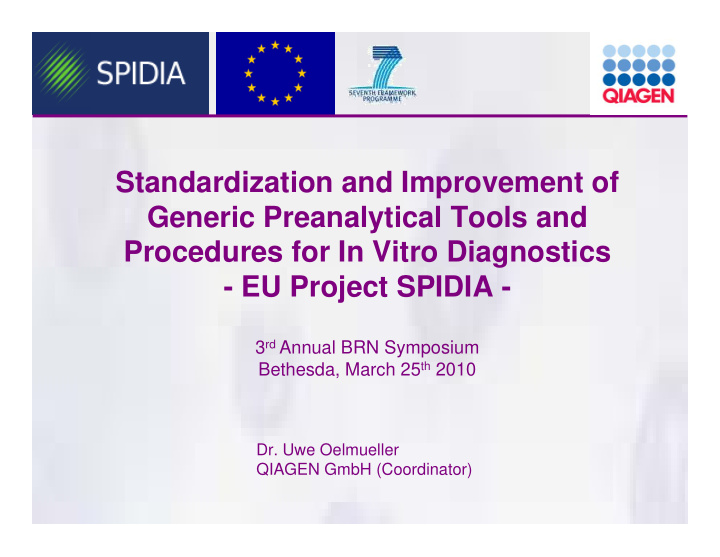



Standardization and Improvement of Generic Preanalytical Tools and Procedures for In Vitro Diagnostics - EU Project SPIDIA - 3 rd Annual BRN Symposium Bethesda, March 25 th 2010 Dr. Uwe Oelmueller QIAGEN GmbH (Coordinator)
Agenda � Preanalytical Workflow Challenges � SPIDIA Project Project History � Project Goals and Structure � Status
Agenda � Preanalytical Workflow Challenges � SPIDIA Project Project History � Project Goals and Structure � Status
From Patient Samples to Clinical Result Patient Assay Clinical Sample technologies sample technologies Results Protein DNA / RNA MDx Assays Sample Stabilization Logistics Storage Retrieval RNA Collection Storage Data mgmt Data mgmt Automated Integration Enabling Drug Sample to Development Sample prep Detection Technologies Platforms
Ex Vivo Changes in the Whole Blood RNA Profil EDTA Whole Blood Preserved Whole Blood * t 0 * PAXgene Blood RNA System 8 hr 3 days 5 days Rainen et al.. Clin.Chem. 2002, 48(11):1883-90 4 hr 24 hr
Biomolecules and Morphology: Challenge for Tissue Samples DNA RNA, miRNA Histomorphology Immunohistochemistry In situ Hybridization Western Blot Analysis
Diagnostic Preanalytical Workflow – What is missing? � Knowledge if and how biomolecule profiles change during the process � Nucleic acids, proteins, metabolites � New sub-classes as ncRNA etc. � Each molecule or molecule complex can be different � Individual patient samples can change differently � Can the individual diagnostic assays tolerate the changes? � Intended use, claims, clinical utility � Technologies that prevent biomolecule profile changes � Standardization & guidelines
Agenda � Preanalytical Workflow Challenges � SPIDIA Project Project History � Project Goals and Structure � Status
Project History EC FP7-HEALTH-2007-B Call June 2007 - Funding Scheme: Collaborative Project “Standardisation and improvements of pre-analytical procedures for in vitro diagnostics” Provide pan-European quality assurance schemes and guidelines for pre-analytical procedures such as sample collection, handling, transportation, processing and storing of clinical samples. Tissue samples , blood samples and perhaps other specimens should be considered.
Project History & Facts � June 2007 EC Call publication � Sept. 2007 SPIDIA Grant Proposal � March 2008 SPIDIA favourably evaluated � October 2008 Kick Off Meeting � Consortium 7 public research organizations 8 companies 1 standards organization (CEN) � Coordinator QIAGEN GmbH � Budget 13 Mio € � EC Contribution 9 Mio € � Duration 4 years � Web page www.spidia.eu
Consortium Members � Scientific Advisory Board QIAGEN GmbH - Coordinator � � Prof. François Rousseau Medical University of Graz (Prof. Kurt Zatloukal) (Univ. Laval, Quebec. � University of Florence (Prof. Mario Pazzagli) CanGeneTest Network) � University of Florence � Dr. Roberta M. Madej (CLSI) � TATAA Biocenter � PreAnalytiX GmbH � DIAGENIC ASA Project Ethics Committee � Aros Applied Biotechnology � Dr. Anne Cambon-Thomsen (CNRS, INSERM, Tolouse, � Dako Denmark France) � ACIES � Dr. Ruth Chadwick (ESRC � Biotechnology Inst. of Czech Academy of Centre, Cardiff University, Science UK) � European Committee for Standardization (CEN) � ImmunID Technologies � Erasmus Medical Center Rotterdam � Technical University Munich � Fondazione IRCCS Istituto Nazionale dei Tumori
Agenda � Preanalytical Workflow Challenges � SPIDIA Project Project History � Project Goals and Structure � Status
Main Goals � Pan-european quality assurance schemes and guidelines for the pre-analytical process: blood, tissue – RNA, DNA, Proteins � New tools & technologies that integrate and standardize pre- analytical steps: blood, tissue, non- / less invasive samples � Identification of Biomarkers for monitoring changes in clinical samples: RNA, DNA, Proteins, Metabolites � Training and dissemination of results � Cooperation with international organizations
Project Structure Implementation Guidelines Tool Test in Dx Marker Standards Dissemination Discovery Developments Tissue Training Programs Colon Cancer Tissue Hospitals Blood Neuro- Labs Blood degenerative Testing Diseases RNA, DNA International co- Plasma Proteins operations (CLSI, Cytology, IHC, ISH EFCC, NCI/OBBR ) Metabolism Non-Invasive Metabolites Scientific Advisory Identification of Quality Markers Board - Non EU Tools Tools Standardization Standardization QA Schemes Club of Interest Guidelines
Impacts
Agenda � Preanalytical Workflow Challenges � SPIDIA Project Project History � Project Goals and Structure � Status
Status of SPIDIA‘s Work Newsletter 1 / 2010 � New tissue stabilization & collection technology � RNA/DNA, Proteins, morphology, antigenicity, (> 2.000 human samples) � > 1.500 compounds & combinations screened � New tissue sample laboratory tracking system � Biomolecule profile changes studies in tissues � New stabilization technologies screenings (blood, less invasive samples) � New automated workflow for RNA, ncRNA isolation from stabilized blood samples � Blood ring trials with 320 participants (RNA, DNA, fcNA) � Pre-analytical workflow QA biomarker discovery programs running � Dissemination activities
From Patient Samples to Clinical Result Patient Assay Clinical Sample technologies sample technologies Results Protein DNA / RNA MDx Assays Sample Stabilization Logistics Storage Retrieval RNA Collection Storage Data mgmt Data mgmt Automated Integration Enabling Drug Sample to Development Sample prep Detection Technologies Platforms
Thank you! Questions ?
Recommend
More recommend